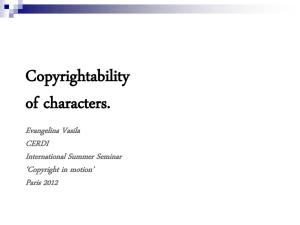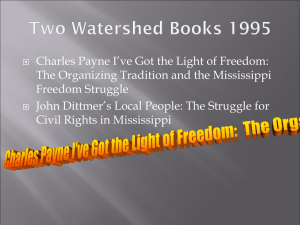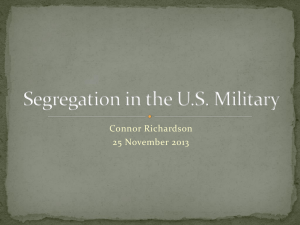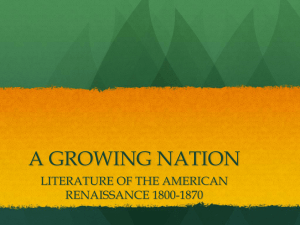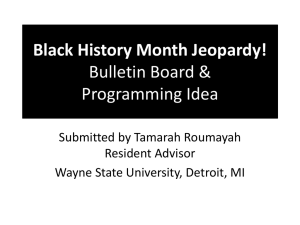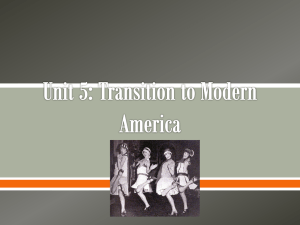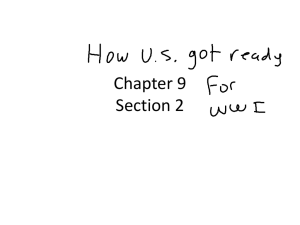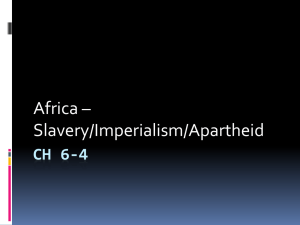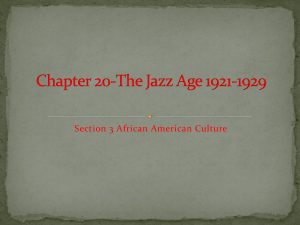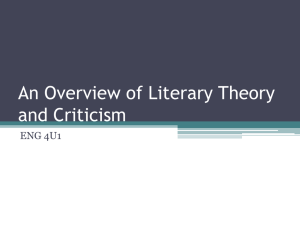PresentAfricanAm - estudiosliterariosdos
advertisement
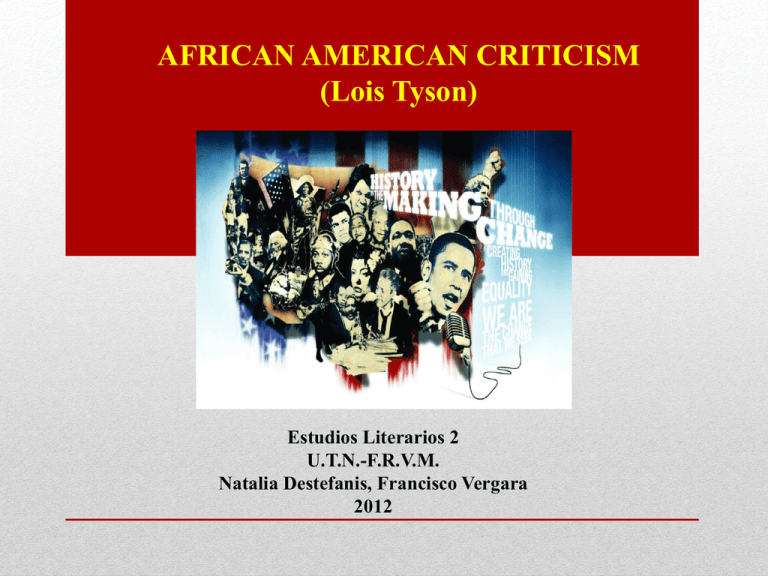
AFRICAN AMERICAN CRITICISM (Lois Tyson) Estudios Literarios 2 U.T.N.-F.R.V.M. Natalia Destefanis, Francisco Vergara 2012 • • • • • Racial Issues and African American Literary History African American Criticism and Literature Attempts to Analyze the African American Literary Tradition Beloved Activities Racial Issues and African American Literary History Until late 1960s Cultural hegemony of white America. Virtual exclusion of African American History: *Slave uprisings during the Middle Passage *Networks of resistance developed by slaves *Harlem Renaissance Key Concepts in African American Criticism • Racialism: Belief in racial superiority • Racism: Sociopolitical domination • Institutionalized Racism: Racist policies and practices in institutions American Literary Canon: Eurocentric definition of universalism Contemporary Black American Authors *Toni Morrison * Nikki Giovanni *Alice Walker *John Edgar Wideman *Maya Angelou *Gloria Naylor *Ishmael Reed *Charles Johnson *Rita Dove *Sherley Anne Williams *August Wilson *Ernest J. Gaines Psychological Results of Racism • Internalized Racism • Intra-racial Racism • Double Consciousness (or Double Vision) “Writing for Whites” Countee Cullen “Writing for Blacks” Langston Hughes Literary style inseparable from writer’s role as a member of an oppressed group. Poetics and Politics • 18th Cent.: Writing as proof of humanity • Black Arts Movement of the 1960s: -Black writers (and critics) have an obligation to help the race through literary means -Questioning of Deconstructionism -Opposition to the notion of “Universality” African oral tradition of storytelling and folklore Afrocentricity: Primacy of relationship to African culture e.g.: Trickster tales African American Criticism and Literature Recurring historical and sociological themes • Reflection of the politics of black American experience. • Until the mid-twentieth century, black writers had to treat racially charged subjects carefully or encode them in their writing Correcting stereotypes, omissions, and misrepresentations Prominent Features • Orality: *Black Vernacular English. Copying the rhythms o of black speech *Repeating important phrases. Alternating voices • Folk Motifs: *Range of character types and folk practices *Sense of continuity with the African and African z American past Character Types • • • • • • • the local healer the conjurer the matriarch the storyteller the trickster the religious leader the folk hero Folk Practices • Singing worksongs, hymns, and the blues • Engaging in folk and religious rituals as a way of maintaining community and continuity with the past; • Storytelling as a way of relating personal and group history and passing down traditional wisdom • Passing down folk crafts and skills • Emphasizing the importance of naming Attempts to Analyze the African American Literary Tradition The Signifying Monkey by Henry Louis Gates • He views African American literary history as a history of relationships among literary texts • People engage in a folk practice called “Signifying” (the term refers to various indirect ways of giving opinions about another person) • A literary application of Gates’s theory: Richard Wright and Ralph Ellison Richard Wright Ralph Ellison - A naturalist - Racist oppression represented in stark language - Aim: to describe the depth of black suffering - A modernist - Human experience represented by ambiguous, metaphorical language - He signifies upon Wright by parodying Wright’s literary structures Attempts to Analyze the African American Literary Tradition Blues, Ideology and African American Literature by Houston Baker • He relates African American literary tradition to an African American folk art: the blues (a form of African American cultural self-expression) • Literary texts and blues songs generally have a double theme: a spiritual theme and a material theme • The material theme does not refer to escaping from or buying oneself out of slavery • It refers to the economic oppression that becomes a form of bondage “when personae, protagonists, autobiographical narrators, or literary critics successfully negotiate an obdurate `economics of slavery´ and achieve a resonant, improvisational expressive dignity” (qtd. in Tyson, 392) African American Women They were excluded from or marginalized by the African American Literary Canon They have been represented in literary works as stereotyped characters They have been concerned to portray black women as real people with the complexity that they have According to Washington, black women must negotiate the requirements of their relationship to the black community and to women of all races to resist sexist oppression. Recurring Themes • Underpaid workers • Victims of violence and sexual exploitation • Their community • White standards of beauty • Passing for white African American Women Black women writers have a revisionist mission to provide readers with realistic female character types Washington describes 3 salient types: • “Suspended woman” • “Assimilated woman” • “Emergent woman” “All these literary devices emphasize the struggle of black women to assert their own identity” (395) • Some critics add a fourth type: “Liberated woman” Recurring Literary Strategies o A black female character as the speaker or narrator o 3rd person narrator: the point-ofview character is also a black woman o Imagery associated with locations within the home o Imagery associated with their physical appearance “All these literary devices emphasize the struggle of black women to assert their own identity” (395) African American Criticism: Insights into Literary Works by White Americans Writers Playing in the Dark: Whiteness and the Literary Imagination by Toni Morrison • She tries to reveal the way in which white texts construct the `Africanist´ presence in American history • The term `Africanist´ refers to the denotative and connotative blackness that African peoples have come to signify and to the range of assumptions that accompany Eurocentric learning about these peoples • The Africanist presence has a negative image • Whites use black characters as a vehicle for illegal sexuality, fear of madness, expulsion and self-loathing Toni Morrison 1931-Lorain, Ohio The Bluest Eye (1970) Song of Solomon (1977) Beloved (1987) Key Concepts in African American Criticism Which of the following concepts of African American Criticism best describes the situation portrayed in School Daze? • • • • • • Internalized Racism Intra-racial Racism Double Consciousness Racialism Afrocentrism Institutionalized Racism The Social Role of the Black Artist (Tyson) Which of the three following positions might be related to the opening scene of Spike Lee’s Malcolm X? • “Cullen (…) believed that black authors should be as free as white authors to create according to the dictates of their own artistic inspiration without being obliged to consider the political needs of their people.” (363) • “Writing as a form of purely individual expression has been viewed by many African Americans as a luxury the race could not afford while so many of its members were oppressed.” (364) • “Such concepts as “center” and “periphery” are illusory.(…) The concept of a stable, inherently meaningful cultural identity” must be questioned. “The “self” is a fragmented collection of numerous “selves” that has no stable meaning or value except those we assign to it.”(365) Works Cited Duvall, John. The Identifying Fictions of Toni Morrison: Modernist Authenticity and Postmodern Blackness. New York: Palgrave Macmillan, 2000. Print. Lee, Spike, dir. Malcolm X. Warner Bros., 1992. Film. Lee, Spike, dir. School Daze. 40 Acres & A Mule Filmworks, 1988. Film. Morrison, Toni. Beloved. New York: Penguin Group, 1998. Print. Tyson, Lois. Critical Theory Today: A User’s Friendly Guide. New York: Routledge, 2006. Print.
